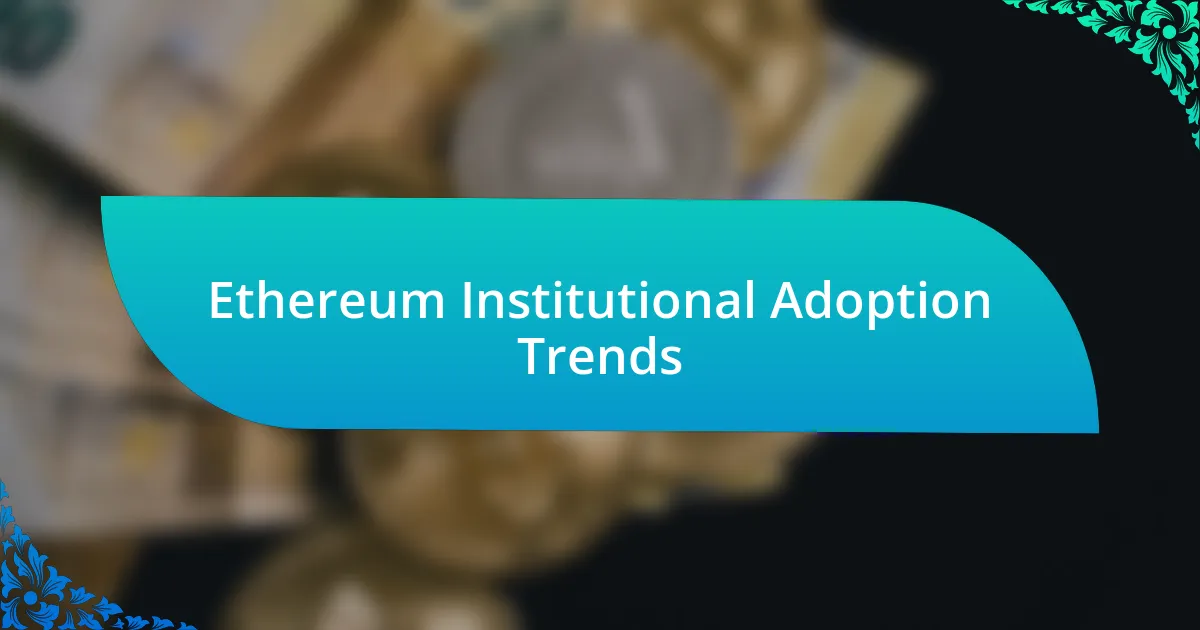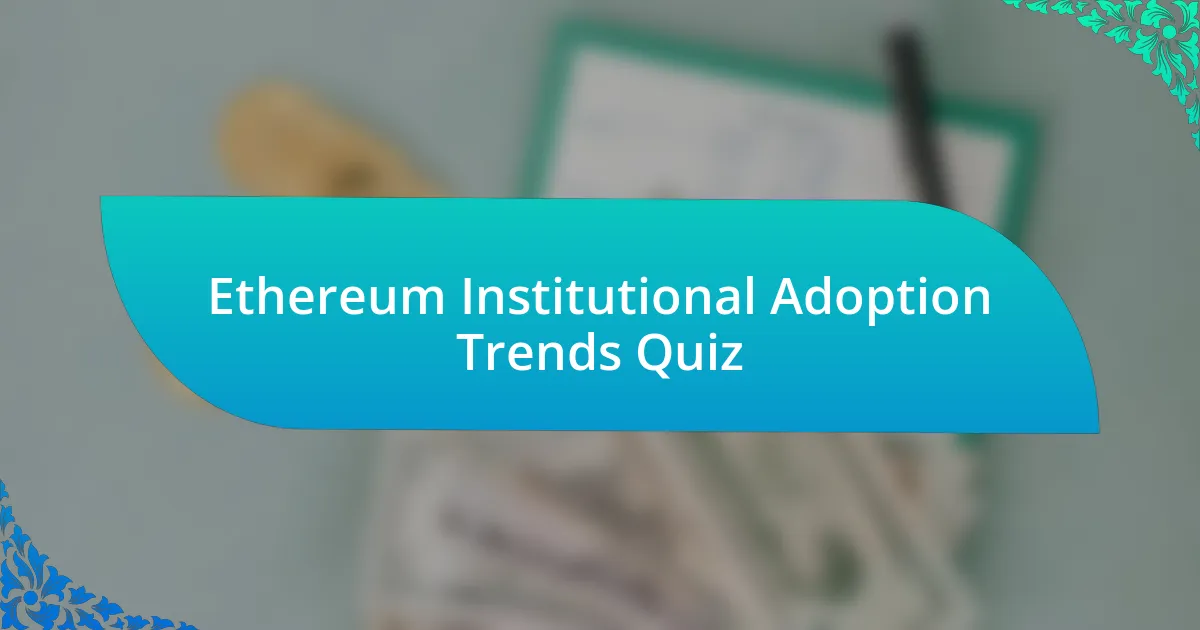
Start of Ethereum Institutional Adoption Trends Quiz
1. What year was Ethereum launched?
- 2015
- 2017
- 2014
- 2016
2. What consensus algorithm has Ethereum transitioned to from its previous model?
- Proof-of-Work
- Byzantine Fault Tolerance
- Delegated Proof-of-Stake
- Proof-of-Stake
3. How do smart contracts operate on the Ethereum platform?
- Smart contracts operate on the Ethereum platform by creating physical documents that users must sign to verify transactions.
- Smart contracts operate on the Ethereum platform by requiring manual processing of all transaction requests from users each time.
- Smart contracts operate on the Ethereum platform by executing code stored on the blockchain when predetermined conditions are met.
- Smart contracts operate on the Ethereum platform by storing user data privately and securely without any execution of code.
4. What has been the change in institutional investor exposure to Ethereum from 2021 to 2023?
- Institutional investor exposure to Ethereum fluctuated between 20% and 30% from 2021 to 2023.
- Institutional investor exposure to Ethereum rose from 31% in 2021 to 39% in 2023.
- Institutional investor exposure to Ethereum dropped from 39% in 2021 to 31% in 2023.
- Institutional investor exposure to Ethereum remained constant at 31% from 2021 to 2023.
5. How much is ether approximately priced at as of 2023?
- $2,700
- $5,000
- $3,500
- $1,900
6. What was the percentage increase in the price of ether over the past year?
- 150%
- 50%
- 300%
- 907%
7. What are the main reasons instigating institutional investment in Ethereum?
- Institutional investors are investing in Ethereum due to regulatory clarity, crypto events, and capital inflows from ETFs.
- Institutional investors are investing in Ethereum solely due to its connection with Bitcoin and its historical price movements.
- Institutional investors are investing in Ethereum primarily for short-term trading opportunities and high volatility.
- Institutional investors are investing in Ethereum mainly because of its low transaction fees and fast processing times.
8. What investment opportunities has the Ethereum ETF created for institutions?
- Increased volatility in the market
- Decreased access to cryptocurrency
- Limitations on institutional trading
- New investment avenues for financial firms
9. In what way do Ethereum ETFs contribute to market stability?
- The approval of ETFs eliminates risks in cryptocurrency trading.
- Ethereum ETFs do not influence the investment patterns in the market.
- The introduction of ETFs attracts institutional investors bringing new capital.
- Ethereum ETFs reduce market volatility by regulating prices.
10. Name a technological upgrade aimed at improving Ethereum`s scalability and efficiency.
- EIP 4844
- EIP 1234
- EIP 2725
- EIP 5678
11. What role do institutional money managers play in the ether open interest market?
- Institutional money managers buy ether for short-term trading.
- Institutional money managers hedge long portfolios against volatility.
- Institutional money managers focus solely on public stocks.
- Institutional money managers avoid high-risk investments.
12. Who is managing the volatility associated with Ethereum products?
- Private equity firms
- Real estate investors
- Hedge fund managers
- Traditional finance arbitrageurs
13. What effect has the demand for NFTs and DeFi had on Ethereum`s ecosystem?
- It is expected to increase independence in price behavior.
- It will lead to a decrease in transaction speeds.
- It has no effect on market stability.
- It causes Ethereum to become less scalable.
14. What portion of institutional respondents allocate more than 1% of their portfolio to digital assets?
- 15%
- 60%
- 45%
- 25%
15. How do smaller asset under management (AUM) institutions usually allocate to digital assets?
- Institutions with smaller AUM usually invest exclusively in traditional assets.
- Institutions with smaller AUM primarily focus on real estate investments.
- Institutions with smaller AUM typically avoid digital assets entirely.
- Institutions with smaller AUM tend to allocate a greater portion of their portfolio to digital assets.
16. How do institutions plan to adjust their digital asset investments in the near future?
- Organizations plan to exit the digital asset market completely within a year.
- Institutions have decided to maintain their current levels of investment indefinitely.
- Most organizations plan to scale their investments over the next two to three years.
- Institutions will reduce their investments in digital assets drastically.
17. What are institutions exploring regarding tokenization in the upcoming years?
- Institutions are planning to eliminate all digital assets from their portfolios.
- Institutions want to focus solely on traditional investments without tokenization.
- Institutions are hesitant and delaying any investments in tokenized assets.
- Institutions are looking to invest in tokenized assets and tokenize their own assets.
18. Which class of investors shows the most enthusiasm for investing in tokenized assets?
- Corporate bond investors
- Hedge funds
- Retail investors
- Real estate investors
19. What are the current blockchain specifications like block time and average block size for Ethereum?
- The block time is 14 seconds, and the average block size is 2 KB.
- The block time is 30 seconds, and the average block size is 500 KB.
- The block time is 10 minutes, and the average block size is 1 MB.
- The block time is 20 seconds, and the average block size is 1.5 KB.
20. Are all transactions on the Ethereum network publicly visible?
- Only large transactions are visible.
- Transactions are visible only to miners.
- No, transactions are completely hidden.
- Yes, all transactions on the Ethereum network are public.
21. What is the purpose of a user`s private key in the Ethereum network?
- To store transaction history permanently.
- To initiate new Ethereum contracts.
- To sign transactions securely.
- To encrypt user data completely.
22. What occurs if gas runs out before a transaction completes on Ethereum?
- The transaction is completed as is, consuming no gas.
- The miner loses their fee and has to wait for the next transaction.
- All state changes are reversed, and the used Ethereum Gas is given to the miner.
- The transaction fails silently with no impact on the network.
23. How does Ethereum verify account balances in real-time?
- Ethereum uses a third-party service to verify balances.
- Ethereum relies on time stamps to determine account balances.
- Ethereum requires users to calculate their own balances manually.
- Ethereum checks the latest state for account balances.
24. In what way does Bitcoin validate its transaction outputs?
- Bitcoin checks unspent transaction outputs (UTXO)
- Bitcoin validates outputs through user confirmations
- Bitcoin uses network speed to verify transaction outputs
- Bitcoin checks transaction fees to validate outputs
25. What is the function of MetaMask in the Ethereum ecosystem?
- MetaMask is a popular browser-based Ethereum wallet that can be used to interact with decentralized applications (dApps) on the Ethereum network.
- MetaMask is a decentralized exchange for trading ether directly.
- MetaMask is a social media platform for Ethereum users to connect.
- MetaMask is a system for mining Ethereum and generating new coins.
26. What purpose does Truffle serve in Ethereum development?
- Truffle is an NFT marketplace built on Ethereum.
- Truffle is a cryptocurrency wallet for Ethereum coins.
- Truffle is a development framework for Ethereum projects.
- Truffle is a consensus algorithm for Ethereum.
27. What does Remix specialize in within the Ethereum framework?
- Remix specializes in mining Ether.
- Remix specializes in trading cryptocurrencies.
- Remix specializes in developing smart contracts.
- Remix specializes in creating digital wallets.
28. What impact does EIP 4844 have on Ethereum’s functionality?
- EIP 4844 adds a new consensus mechanism to Ethereum.
- EIP 4844 improves Ethereum`s scalability by introducing roll-up technology.
- EIP 4844 eliminates the need for gas fees on the Ethereum network.
- EIP 4844 reduces transaction fees for all users on Ethereum.
29. How does the Ethereum ETF approval amplify institutional acceptance?
- It eliminates all risks associated with cryptocurrency.
- It provides a regulated product for investors.
- It reduces transaction fees for all users.
- It lowers the market value of ether.
30. What hurdles do institutions encounter when investing in digital assets?
- Regulatory uncertainty and security concerns
- High advertising costs
- Increase in transaction speed
- Lack of consumer interest

Quiz Completed Successfully!
Congratulations on completing the quiz on Ethereum Institutional Adoption Trends! We hope you enjoyed testing your knowledge and learned something new along the way. Diving into the intricacies of Ethereum’s adoption by institutions can be fascinating. You’ve explored key trends, notable case studies, and the impacts of such adoption on the broader financial landscape.
Throughout this quiz, you may have discovered the reasons behind institutional interest in Ethereum. You learned about the potential benefits, such as smart contracts and decentralized finance. Additionally, you gained insight into the challenges institutions face when integrating blockchain technology. This understanding is crucial as the landscape continues to evolve.
To further enhance your knowledge, we invite you to check the next section on this page. It offers in-depth information on Ethereum Institutional Adoption Trends. This resource will provide you with more detailed analysis and insights, helping you stay informed as this exciting area of blockchain technology progresses. Happy learning!

Ethereum Institutional Adoption Trends
Overview of Ethereum Institutional Adoption
Ethereum is increasingly being recognized by institutional investors as a valid asset class. This trend illustrates a shift in market perceptions, highlighting Ethereum’s smart contract capabilities and decentralized applications. Major financial institutions, hedge funds, and corporations are exploring Ethereum for its potential in blockchain technology, innovation, and investment diversification.
Key Drivers of Institutional Adoption
Institutional adoption of Ethereum is driven by several factors. These include its established network, growing developer community, and increasing use cases in finance and beyond. Additionally, the rise of decentralized finance (DeFi) platforms built on Ethereum showcases real-world applications, attracting institutional investment. Regulatory clarity and improved market infrastructure also facilitate this trend.
Institutional Investment Products Related to Ethereum
Various institutional investment products centered around Ethereum have emerged. These include exchange-traded funds (ETFs), futures contracts, and managed funds specifically focused on Ethereum. Such products allow institutional investors to gain exposure to Ethereum’s price movements without directly holding the asset, thereby aligning with their investment strategies and risk management approaches.
Cases of Major Institutions Adopting Ethereum
Several prominent institutions have publicly embraced Ethereum. Companies like JPMorgan have developed blockchain solutions using Ethereum technology. Additionally, investment firms like Grayscale offer Ethereum Trusts, which allow institutional clients to invest in Ethereum in a regulated manner. These cases exemplify growing institutional commitment to Ethereum.
Future Trends in Ethereum Institutional Use
The future of Ethereum institutional adoption looks promising. As Ethereum transitions to Ethereum 2.0, scalability and sustainability improvements are expected to enhance its appeal. Institutions may increasingly explore Ethereum for programmable assets, tokenization of real-world assets, and increased participation in DeFi markets. This evolving landscape is likely to foster further institutional engagement with Ethereum.
What are Ethereum institutional adoption trends?
Ethereum institutional adoption trends refer to the increasing interest and participation of institutional investors and firms in the Ethereum blockchain and its native cryptocurrency, Ether (ETH). Over the past few years, this interest has been driven by the growth of decentralized finance (DeFi) and non-fungible tokens (NFTs) built on the Ethereum network. For example, reports from firms like CoinShares indicate that institutional investment in Ethereum products rose significantly, with Ethereum accounting for 26% of total crypto investment products in mid-2021.
How is institutional adoption of Ethereum measured?
Institutional adoption of Ethereum is measured by various indicators, including the volume of Ether traded in institutional investment products, the number of institutional wallets created, and participation in Ethereum-focused funds. Data from Glassnode shows that the number of entities holding over 1,000 ETH has steadily increased, signaling growing institutional interest. Additionally, survey reports by Fidelity Digital Assets indicate that a notable percentage of institutional investors are considering or have already invested in Ethereum.
Where are the primary sources of institutional interest in Ethereum located?
The primary sources of institutional interest in Ethereum are located predominantly in North America and Europe. Major financial hubs like New York and London have seen significant activity from hedge funds and family offices investing in Ethereum. A report by PwC highlighted that 86% of survey respondents from these regions are planning to invest in digital assets, including Ethereum, emphasizing growing interest in these markets.
When has institutional adoption of Ethereum notably increased?
Institutional adoption of Ethereum notably increased in 2020 and 2021, coinciding with the broader cryptocurrency market boom. The launch of Ethereum 2.0 in December 2020, along with the rise of DeFi, attracted institutional attention. A report by Fidelity found that 36% of institutional investors expressed interest in cryptocurrencies, with Ethereum being a primary focus. This trend was marked by significant investments from firms like Grayscale, which launched the Ethereum Trust in 2019 and saw its assets under management surpass $3 billion within a year.
Who are the key players in Ethereum’s institutional adoption?
The key players in Ethereum’s institutional adoption include asset management firms like Grayscale and Fidelity Digital Assets, blockchain infrastructure companies such as ConsenSys and Alchemy, and major financial institutions like JPMorgan and Goldman Sachs. Grayscale, for instance, has one of the largest Ethereum investment trusts, exceeding billions in assets. Reports indicate that investment by these firms has been pivotal in promoting Ethereum to institutional investors, making them essential contributors to its adoption.

